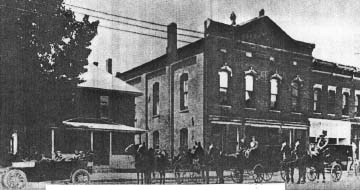| | the alley north of the Post Office, to Road 13. Halderman had entered the 80 acres east of Ogan's south 80 and a short time later purchased Ogan's south 80. On this tract is the Central Junior High School and the Old Cemetery along Market Street. In laying out what is now the original plat each owner, Ogan, Neff and Halderman retained ownership of their lands and the platted lots. Neff did not remain long in North Manchester but sold his holdings and returned to Preble County, Ohio, where he died. A death in the Halderman family caused him to set aside the Old Cemetery tract and in later years the Halderman heirs deeded the cemetery to the Town of North Manchester. For many years nothing was known of the Ogan family. This writer (Harry Leffel) traced the family to Richmond, Indiana, and a photostatic copy of the will of Samuel Ogan recorded at Richmond is now in the files of the News Journal. The will, probated February 15, 1843 names the following children in bequests: Peter and John, who had located in the North Manchester vicinity, Elias, who lived at Somerset; Lewis, who later died at Richmond , and who owned a farm later owned by Dorsey Brandenburg east of North Manchester; Stephen, Jasper County, Esther, wife of James Hendrix, Richmond; and Phemy, wife of Martin Elliott, Jasper County. The family probably originated in Eastern Pennsylvania. John Ogan operated a grist mill on Pony Creek, just south of the Road 113 bridge. He and his family were buried in the north part of the Old Cemetery. The Albert and James and Miss Sadie Rooney of Laketon were grandchildren of John Ogan. Lots l and 2 of the original plat extend east from the Williams drug store building to the west edge of Walnut Street if extended to the River. Peter and Mary Ann Ogan, his wife, sold those lots, which included the Ogan cabin to John and Jane Townsend December 22, 1843 for $100. Early accounts say the Ogans operated a tavern in the early days of the town, but the exact location is not known. Peter was busy in other matters. He built a dam across Eel River just below the covered bridge, dug a mill race across the nack of land, joining the river again near the later Farm Bureau Lumber Yard on South Mill Street and proceeded to build a saw mill. Later a flume mill race to furnish water power for a foundry and machine shop owned by Samuel Leonard. After starting the saw mill, Ogan added a buhr mill to grind grain. | |

